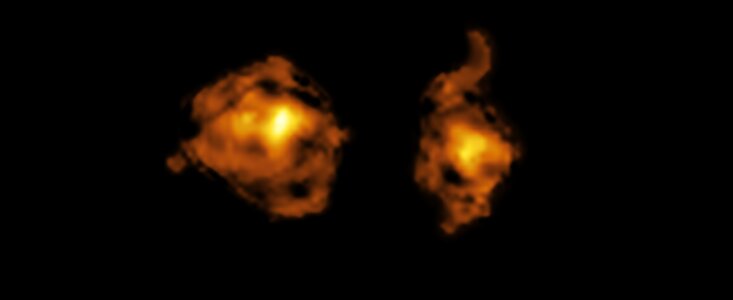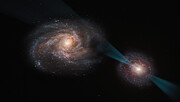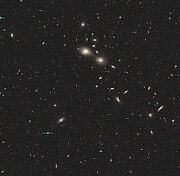Comunicato Stampa
'Giostra cosmica': gli astronomi osservano una coppia di galassie che si combatte nello spazio profondo
21 Maggio 2025
Gli astronomi hanno assistito per la prima volta a una violenta collisione cosmica in cui una galassia ne trafigge un'altra con un'intensa radiazione. I risultati, pubblicati oggi su Nature, mostrano che questa radiazione smorza la capacità della galassia ferita di formare nuove stelle. Il nuovo studio ha combinato osservazioni del VLT (Very Large Telescope) dell'ESO (Osservatorio Europeo Australe) e di ALMA (Atacama Large Millimeter/submillimeter Array), rivelando tutti i dettagli cruenti di questa battaglia galattica.
In una zona remota dell'Universo, due galassie sono impegnate in una guerra avvincente. Caricano ripetutamente l'una contro l'altra a velocità di 500 km/s su una violenta rotta di collisione, solo per assestare un colpo di striscio prima di ritirarsi e prepararsi per un altro round. "Per questo chiamiamo questo sistema 'giostra cosmica'", afferma Pasquier Noterdaeme, co-responsabile dello studio e ricercatore presso l'Istituto di Astrofisica di Parigi, in Francia, e il Laboratorio Franco-Cileno di Astronomia in Cile, facendo un paragone con lo sport medievale. Ma questi cavalieri galattici non sono realmente cavallereschi, e uno di loro ha un vantaggio decisamente sleale: usa un quasar per trafiggere l'avversario con una lancia di radiazioni.
Il quasar è il nucleo luminoso di alcune galassie lontane, alimentato da un buco nero supermassiccio, che rilascia enormi quantità di radiazioni. Sia i quasar che la fusione tra galassie erano molto più comuni nel passato: più frequenti nei primi miliardi di anni di vita dell'Universo, quindi per osservarli gli astronomi scrutano il lontano passato con potenti telescopi. La luce di questa "giostra cosmica" ha impiegato oltre 11 miliardi di anni per raggiungerci, quindi la vediamo com'era quando l'Universo aveva solo il 18% dell'età attuale.
"Qui vediamo per la prima volta l'effetto della radiazione di un quasar direttamente sulla struttura interna del gas in una galassia altrimenti normale", spiega Sergei Balashev, co-responsabile dello studio e ricercatore presso l'Istituto Ioffe di San Pietroburgo, in Russia. Le nuove osservazioni indicano che la radiazione rilasciata dal quasar disgrega le nubi di gas e polvere nella galassia normale, lasciando indietro solo le regioni più piccole e dense, probabilmente troppo piccole per essere in grado di formare stelle, e provocando una notevole trasformazione che lascia la galassia ferita con meno incubatrici stellari.
Ma la vittima galattica non è l'unica a essere trasformata. Balashev spiega: "Si pensa che queste fusioni portino enormi quantità di gas ai buchi neri supermassicci che risiedono nel centro delle galassie". Nella giostra cosmica, nuove riserve di combustibile vengono messe alla portata del buco nero che alimenta il quasar. Mentre il buco nero si alimenta, il quasar può continuare il suo attacco distruttivo.
Lo studio è stato condotto utilizzando ALMA e lo strumento X-shooter montato sul VLT dell'ESO, entrambi situati nel deserto di Atacama in Cile. L'alta risoluzione di ALMA ha aiutato gli astronomi a distinguere chiaramente le due galassie in fusione, così vicine da apparire come un singolo oggetto nelle osservazioni precedenti. Con X-shooter, i ricercatori hanno analizzato la luce del quasar mentre attraversava la galassia normale. Questo ha permesso al gruppo di lavoro di studiare come la galassia abbia sofferto a causa della radiazione del quasar in questa lotta cosmica.
Osservazioni con telescopi più grandi e potenti potrebbero rivelare di più su collisioni come questa. Come afferma Noterdaeme, un telescopio come l'ELT (Extremely Large Telescope) dell'ESO "ci consentirà sicuramente di compiere uno studio più approfondito di questo e di altri sistemi, per comprendere meglio l'evoluzione dei quasar e il loro effetto sulla galassia ospitie e su quelle vicine".
Ulteriori Informazioni
Questo risultato è stato descritto in un articolo pubblicato sulla rivista Nature, intitolato “Quasar radiation transforms the gas in a merging companion galaxy.” (doi: 10.1038/s41586-025-08966-4)
L'equipe è composta da S. Balashev (Ioffe Institute, St Petersburg, Russia), P. Noterdaeme (Institut d’Astrophysique de Paris, Paris, Francia [IAP] & French-Chilean Laboratory for Astronomy [FCLA], Cile), N. Gupta (Inter-University Centre for Astronomy, Pune, India [IUCAA]), J.K. Krogager (Université Lyon I, Lyon, Francia & FCLA), F. Combes (Collège de France, Paris, Francia), S. López (Universidad de Cile [UChile]), P. Petitjean (IAP), A. Omont (IAP), R. Srianand (IUCAA), e R. Cuellar (UChile).
ALMA, l'Atacama Large Millimeter/submillimeter Array, un osservatorio astronomico internazionale, è una collaborazione fra l'Europa, la U.S. National Science Foundation (NSF) e gli Istituti Nazionali di Scienze Naturali del Giappone (NINS), in cooperazione con la repubblica del Cile. ALMA è stato fondato dall'ESO per conto dei suoi stati membri, dall'NSF in cooperazione con il National Research Council del Canada (NRC) e il National Science Council di Taiwan (NSC) e dal NINS in cooperazione con l'Accademia Sinica di Taiwan (AS) e l'Istituto di Astronomia e Scienze Spaziali della Corea (KASI). La costruzione e la gestione di ALMA sono condotte dall'ESO per conto dei suoi stati membri, dall'Osservatorio Nazionale di Radio Astronomia (NRAO) gestito dalle Associated Universities, Inc. (AUI) per conto del Nord America e dall'Osservatorio Astronomico Nazionale del Giappone (NAOJ) per conto dell'Asia Orientale. L'osservatorio congiunto di ALMA (JAO: Joint ALMA Observatory) fornisce la guida unitaria e la gestione della costruzione, del commissioning e delle operazioni di ALMA.
L'ESO (European Southern Observatory o Osservatorio Europeo Australe) consente agli scienziati di tutto il mondo di scoprire i segreti dell'Universo a beneficio di tutti. Progettiamo, costruiamo e gestiamo da terra osservatori di livello mondiale - che gli astronomi utilizzano per affrontare temi interessanti e diffondere il fascino dell'astronomia - e promuoviamo la collaborazione internazionale per l'astronomia. Fondato come organizzazione intergovernativa nel 1962, oggi l'ESO è sostenuto da 16 Stati membri (Austria, Belgio, Danimarca, Francia, Finlandia, Germania, Irlanda, Italia, Paesi Bassi, Polonia, Portogallo, Regno Unito, Repubblica Ceca, Spagna, Svezia e Svizzera), insime con il paese che ospita l'ESO, il Cile, e l'Australia come partner strategico. Il quartier generale dell'ESO e il Planetario e Centro Visite Supernova dell'ESO si trovano vicino a Monaco, in Germania, mentre il deserto cileno di Atacama, un luogo meraviglioso con condizioni uniche per osservare il cielo, ospita i nostri telescopi. L'ESO gestisce tre siti osservativi: La Silla, Paranal e Chajnantor. Sul Paranal, l’ESO gestisce il VLT (Very Large Telescope) e il VLTI (Very Large Telescope Interferometer), così come due telescopi per survey, VISTA, che lavora nell'infrarosso, e VST (VLT Survey Telescope) in luce visibile. Sempre a Paranal l'ESO ospiterà e gestirà la schiera meridionale di telescopi di CTA, il Cherenkov Telescope Array Sud, il più grande e sensibile osservatorio di raggi gamma del mondo. Insieme con partner internazionali, l’ESO gestisce APEX e ALMA a Chajnantor, due strutture che osservano il cielo nella banda millimetrica e submillimetrica. A Cerro Armazones, vicino a Paranal, stiamo costruendo "il più grande occhio del mondo rivolto al cielo" - l'ELT (Extremely Large Telescope, che significa Telescopio Estremamente Grande) dell'ESO. Dai nostri uffici di Santiago, in Cile, sosteniamo le operazioni nel paese e collaboriamo con i nostri partner e la società cileni.
La traduzione dall'inglese dei comunicati stampa dell'ESO è un servizio dalla Rete di Divulgazione Scientifica dell'ESO (ESON: ESO Science Outreach Network) composta da ricercatori e divulgatori scientifici da tutti gli Stati Membri dell'ESO e altri paesi. Il nodo italiano della rete ESON è gestito da Anna Wolter.
Links
- Articolo scientifico
- Fotografie del VLT
- Fotografie di ALMA
- Per i giornalisti: iscrivetevi per ricevere i nostri comunicati sotto embargo nella vostra lingua e fate domanda per un visita strategica all'ESO (con parziale supporto finanziario) nel 2025 (Novità)
- Per i ricercatori: avete una storia da raccontare? Promuovete il vostro articolo scientifico
- Una nuova analisi dell'ESO conferma che gravi danni sarebbero causati dal complesso industriale pianificato vicino al Paranal
Contatti
Pasquier Noterdaeme
Institut d'Astrophysique de Paris
Paris, France
Tel.: +33 1 44 32 81 65
E-mail: noterdaeme@iap.fr
Sergei Balashev
Ioffe Institute
St Petersburg, Russia
Tel.: +7 921 970 2553
E-mail: s.balashev@gmail.com
Bárbara Ferreira
ESO Media Manager
Garching bei München, Germany
Tel.: +49 89 3200 6670
Cell.: +49 151 241 664 00
E-mail: press@eso.org
Joerg Gasser (press contact Svizzera)
Rete di divulgazione scientifica dell'ESO
E-mail: eson-switzerland@eso.org
Sul Comunicato Stampa
| Comunicato Stampa N": | eso2509it-ch |
| Science data: | 2025Natur.641.1137B |
Our use of Cookies
We use cookies that are essential for accessing our websites and using our services. We also use cookies to analyse, measure and improve our websites’ performance, to enable content sharing via social media and to display media content hosted on third-party platforms.
ESO Cookies Policy
The European Organisation for Astronomical Research in the Southern Hemisphere (ESO) is the pre-eminent intergovernmental science and technology organisation in astronomy. It carries out an ambitious programme focused on the design, construction and operation of powerful ground-based observing facilities for astronomy.
This Cookies Policy is intended to provide clarity by outlining the cookies used on the ESO public websites, their functions, the options you have for controlling them, and the ways you can contact us for additional details.
What are cookies?
Cookies are small pieces of data stored on your device by websites you visit. They serve various purposes, such as remembering login credentials and preferences and enhance your browsing experience.
Categories of cookies we use
Essential cookies (always active): These cookies are strictly necessary for the proper functioning of our website. Without these cookies, the website cannot operate correctly, and certain services, such as logging in or accessing secure areas, may not be available; because they are essential for the website’s operation, they cannot be disabled.
Functional Cookies: These cookies enhance your browsing experience by enabling additional features and personalization, such as remembering your preferences and settings. While not strictly necessary for the website to function, they improve usability and convenience; these cookies are only placed if you provide your consent.
Analytics cookies: These cookies collect information about how visitors interact with our website, such as which pages are visited most often and how users navigate the site. This data helps us improve website performance, optimize content, and enhance the user experience; these cookies are only placed if you provide your consent. We use the following analytics cookies.
Matomo Cookies:
This website uses Matomo (formerly Piwik), an open source software which enables the statistical analysis of website visits. Matomo uses cookies (text files) which are saved on your computer and which allow us to analyze how you use our website. The website user information generated by the cookies will only be saved on the servers of our IT Department. We use this information to analyze www.eso.org visits and to prepare reports on website activities. These data will not be disclosed to third parties.
On behalf of ESO, Matomo will use this information for the purpose of evaluating your use of the website, compiling reports on website activity and providing other services relating to website activity and internet usage.
Matomo cookies settings:
Additional Third-party cookies on ESO websites: some of our pages display content from external providers, e.g. YouTube.
Such third-party services are outside of ESO control and may, at any time, change their terms of service, use of cookies, etc.
YouTube: Some videos on the ESO website are embedded from ESO’s official YouTube channel. We have enabled YouTube’s privacy-enhanced mode, meaning that no cookies are set unless the user actively clicks on the video to play it. Additionally, in this mode, YouTube does not store any personally identifiable cookie data for embedded video playbacks. For more details, please refer to YouTube’s embedding videos information page.
Cookies can also be classified based on the following elements.
Regarding the domain, there are:
- First-party cookies, set by the website you are currently visiting. They are stored by the same domain that you are browsing and are used to enhance your experience on that site;
- Third-party cookies, set by a domain other than the one you are currently visiting.
As for their duration, cookies can be:
- Browser-session cookies, which are deleted when the user closes the browser;
- Stored cookies, which stay on the user's device for a predetermined period of time.
How to manage cookies
Cookie settings: You can modify your cookie choices for the ESO webpages at any time by clicking on the link Cookie settings at the bottom of any page.
In your browser: If you wish to delete cookies or instruct your browser to delete or block cookies by default, please visit the help pages of your browser:
Please be aware that if you delete or decline cookies, certain functionalities of our website may be not be available and your browsing experience may be affected.
You can set most browsers to prevent any cookies being placed on your device, but you may then have to manually adjust some preferences every time you visit a site/page. And some services and functionalities may not work properly at all (e.g. profile logging-in, shop check out).
Updates to the ESO Cookies Policy
The ESO Cookies Policy may be subject to future updates, which will be made available on this page.
Additional information
For any queries related to cookies, please contact: pdprATesoDOTorg.
As ESO public webpages are managed by our Department of Communication, your questions will be dealt with the support of the said Department.







